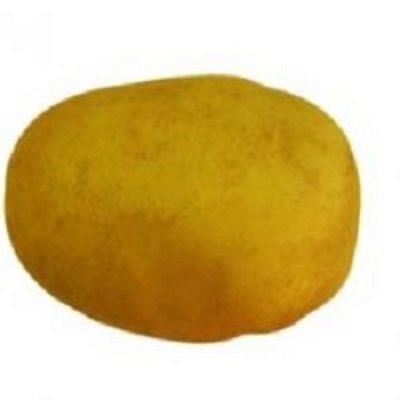
- Authors: Nezakonova L.V., Rusetskiy N.V., Pingol A.P., Erchik V.M., Belarus (RUE "Scientific and Production Center of the National Academy of Sciences of Belarus for Potato and Horticulture")
- Year of approval: 2011
- Appointment: dining room
- Tuber weight, g: 78-120
- Peel color: yellow
- Color of the pulp: cream
- Starch content,%: 12,7-18,4%
- Tuber shape: oval-rounded
- Peel structure: smooth
- The soil: suitable for growing on all types of soil
It's no secret that Belarusians traditionally love, know how, and grow large quantities of potatoes, paying a lot of attention to this culture. Sometimes Belarus is even called the second homeland of South American culture. Belarusian breeders do not stop working either. Among the relatively recent developments is the Ragneda potato variety, which has already become popular with many gardeners.
Breeding history
More than 10 years ago, in 2008, this potato variety was born. This happened thanks to a team of Belarusian breeders consisting of L. Nezakonova, N. Rusetsky, A. Pingol, V. Erchik. The work was carried out at the Scientific Research Center of the National Academy of Sciences of Belarus for potato and horticultural production. To obtain the Ragneda variety, scientists crossed the potato variety Charodey with the form 1579-14. In 2011, the culture received a registration in the Russian State Register of Breeding Achievements.
Description of the variety
Ragneda has many positive properties: it is resistant to ailments, unpretentious, the fruits are tasty. A feature of the Belarusian variety is that it quickly adapts to a wide variety of soil types, different growing conditions. It is for this reason that this variety is so relevant for cultivation in different regions and for novice gardeners. The culture is distinguished by its impressive keeping quality, which is 97%. The main thing is to keep the temperature in the storage facilities from 0 to + 2 ° C, however, this may not always be possible in simple village cellars.
Characteristics of the appearance of the bush and root crops
Ragneda bushes can grow quite tall, but not sprawling. A large number of leaves are formed on them, which are of medium size. The leaf plates are even, green or light green. Waviness along the edge is weak.
Root crops are formed in the amount of 12-14 pieces per bush. Moreover, the weight of each tuber is 78–120 g, they differ in oval or round shape. The eyes on the tubers are not set very deeply. The peel of the root vegetable is yellow, the flesh is creamy.
Purpose and taste of tubers
The Belarusian table type of potato is ranked as the culinary type of the BC. Ragneda's taste characteristics are assessed as good and excellent. There is quite a significant amount of starch in the composition: 12.7-18.4%, which is why the tubers are well boiled. Therefore, a great mashed potatoes are always prepared from these potatoes.
Maturation
Ragneda is a medium late potato in terms of ripening. It matures after 4 months. after the appearance of the first leaves.
Yield
Potatoes from Belarus have gained such popularity not only due to their characteristics, but also due to their high yield. On average, this figure is 187–353 c / ha. The maximum yield is quite high: 431 c / ha.
Growing regions
According to Rosreestr, the culture in question is zoned for the Central and Northwestern regions. But the spread of culture was not limited to these territories. The popularity of the variety is growing every year, and today potatoes are also cultivated in other regions of the Russian Federation and Ukraine.
Growing and care
The optimal time for planting Ragneda will be when the soil temperature at a depth of 10 cm rises to + 8 ° C. You can navigate by folk signs. So, the right time for planting potatoes will be the moment when the birch just begins to be covered with young foliage. Planting the described potato variety is possible almost anywhere, the main thing is that tomatoes do not grow on it earlier, since these crops are attacked by the same pests, and they suffer from the same diseases.
Ragneda's landing pattern is sparse. So, between the tubers it is necessary to leave 15–20 cm, and the row spacing should be from 70 to 90 cm. Only in this case the plants will receive enough space to form a good harvest.
The culture, in principle, is unpretentious in care and growth conditions, but in order to obtain a yield above average, the necessary agrotechnical procedures will have to be performed. Ragneda needs hilling at least 2 times:
- when the bushes grow up to 15–20 cm;
- a few days before flowering, while the plants have not yet closed.
If you huddle potatoes with mowed grass and humus, this will be a top dressing for the bushes. Other top dressing works well with the irrigation procedure, which is so useful during the flowering period of the crop.

Planting potatoes is one of the main spring activities traditional for Russian gardeners. There are many ways to plant this vegetable, allowing you to get a good harvest in different conditions and climates. Before planting, you need to carefully prepare the planting material, correctly determine the timing, competently prepare the soil.



Disease and pest resistance
This potato is quite resistant to late blight. And also Ragneda is able to withstand such ailments as potato cancer, golden cyst nematode, some types of mosaics, as well as the leaf roll virus.

Potatoes are a popular vegetable crop that many gardeners planted on their site. But growing a bountiful harvest of tasty and large tubers is unlikely to succeed if the beds are not properly protected from the most common diseases and pests. Often, the development of diseases of various etiologies of potatoes goes unnoticed, so it is important to identify the problem in time and eliminate it.
















































































